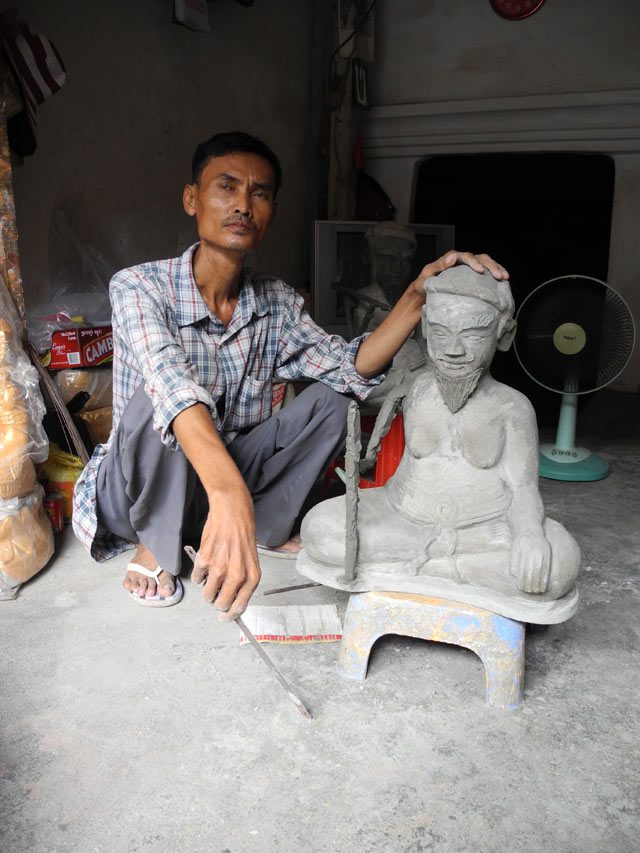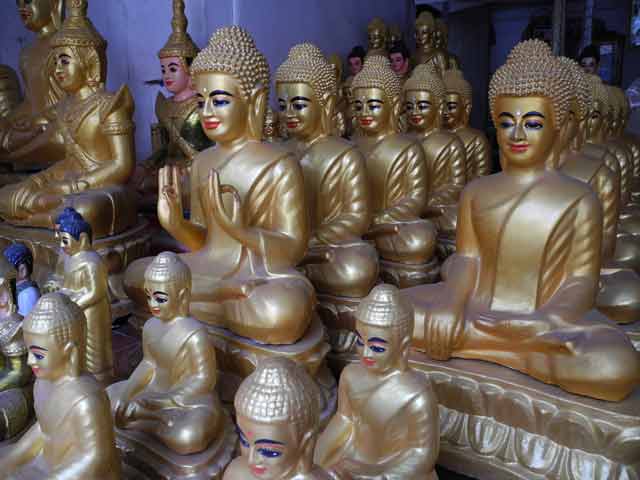Cambodian man bows to Buddha statues during the Day of the Dead (Ancestors’ Day), at a pagoda in Phnom Penh, Cambodia, 14 September 2014. Photo: EPA/MAK REMISSA
Laughing in the shade of his cluttered workshop on the outskirts of Phnom Penh, Chan Sim, 74, states that, despite his age, he is in excellent health. “This,” he says mysteriously, “is because many people pray to my sculptures.”
Chan Sim is the venerable grandfather of Cambodian cement iconography – and he looks the part. With his shimmering gold and green mandarin-collared shirt, long white goatee and gentle smile, it is hard to believe that nearly four decades ago, this soft-spoken artist was being forced to transform animal and human excrement into fertiliser.
Having survived the Khmer Rouge’s genocidal rule by concealing his artistic past, in 1979 Chan Sim returned to Phnom Penh to make cement Buddhas to replace the wood, stone and bronze effigies that had been destroyed by Pol Pot’s army.
“I was the first to do this after the Pol Pot era,” Chan Sim claims, “and I did it for no profit.”
Trained to cast bronze and skilled in the art of carving stone and wood, Chan Sim’s shift to cement – a medium introduced by French colonisers – was entirely pragmatic. “Cement is cheap,” Chan Sim says. “That is why it is so popular.”
Although cement cannot rival the longevity of stone, bronze, or wood, Chan Sim believes that striking art can be created with it. “The beauty of a religious sculpture,” he says, “has nothing to do with when it was made or what it was made of – it depends primarily on the feeling, the inspiration, of the person who created it.” Regular meditation, Chan Sim believes, plays an integral role in this, and so too does scrupulously following the structures and principles of sculpture that have been passed down from the ancients.
However, when visiting modern temples in Cambodia, one quickly sees that Chan Sim’s aesthetic ideals are far from common practice. Disproportionate and gaudily painted, many of the cement Buddhas smiling upon the faithful seem uninspired and cartoonish at best.
In the narrow lanes surrounding Phnom Penh’s Prayuvong Pagoda, dozens of artisans scrape, sand and shape cement into spirit houses, mythical animals and religious icons.
Sok Dul, 45, has been making cement sculptures for nearly 20 years. Previously a motodop driver, he opened his own workshop after a brief apprenticeship with a neighbour. “I enjoy my work,” he says. “I enjoy anything that can earn me money.”
Sok Dul’s tiny workshop is scattered with figures in various stages of completion: iron skeletons waiting to be filled, rough sculptures to sand, featureless icons to be detailed with fresh cement, and near-finished Buddhas waiting for a coat of dazzling gold paint.

A metre-tall sculpture takes Sok Dul one week to make. If he has a previously made mould, the construction process is shortened to three to four days.
“I choose the designs that sell,” Sok Dul says. “I like to make anything that is easy and fast.”
Chan Bunthoeun, 34, has been running a similar workshop for the past three years. “Cement,” he says, “is much easier to work with than stone.” Today he is busy adding some final flourishes to a stylised lion. Nearby, a life-sized Buddha with an oversized head stands watch, palms pressed together in prayer, while Chan Bunthoeun’s four-year-old daughter splashes in the bucket he is working from.
“I like my work,” Chan Bunthoeun says, “and I can easily support my family… Since 1980, there has been a lot of work for cement carvers.”
In its quest to create a new society, ethnologist and archaeologist Ang Choulean estimates that the Khmer Rouge destroyed as many as 95% of all Buddhist sculptures in Cambodia. The only sculptures that were spared, he says, were Hindu deities and museum pieces – icons that were no longer considered ‘living’.
Perhaps equally devastating to Cambodia’s cultural heritage has been the pillaging of ancient artefacts during periods of civil strife. While small-scale looting occurred between the 1970 American-backed coup d’état and the 1975 ascension of the Khmer Rouge, it became rampant in the tumultuous decade that followed Vietnam’s 1989 withdrawal from the country. “This continued,” Ang Choulean says, “until approximately ten years ago… But even today, it still happens.”
Between destruction and looting, few Buddhist sculptures remained. “This is why what you now see in the wats is always something new,” Ang Choulean says, “and I’m sorry to say, but it is very often ugly.”

Nevertheless, it is possible to find talented craftsmen who are producing beautiful religious sculptures today, but these are most often facsimiles of works from the past. Companies like Siem Reap-based Artisans D’Angkor turn out exceptional (and expensive) stone and wood Angkorian reproductions for a predominantly foreign clientele, while sculptors in the provinces of Kampong Thom, Siem Reap and Pursat carve for local customers and pagodas. It is difficult, however, to find inspired or innovative work. Yin Rithy, a stone carver on Phnom Penh’s Street 178, aptly sums up the situation: “I carve what my teacher taught me and what my employer orders,” he says. Although highly skilled, he almost exclusively sculpts dancing Apsaras and Buddhas in meditation.
Ang Choulean considers the current aesthetic decline of Buddhist iconography to be symptomatic of a general decay of religion in Cambodian society. Whereas Buddhist monasteries used to be community-based organisations, Ang Choulean states that they are increasingly becoming controlled by the wealthy. “We are losing our heritage because of money,” he says. “Sculpture, physically, is just one element of the whole… Why should you spend one month creating one statue if you can spend only one week and sell it for the same price?”
Khmer sculpture at a glance
Cambodia’s rich iconographic tradition has its origins in the Funan and Chenla kingdoms that thrived in the region between the 1st and 9th centuries. Influenced by India, the graceful simplicity of the religious sculptures produced in these kingdoms mirror the Greek-inspired icons that emerged in Asia after the 4th century BC conquests of Alexander the Great.
Uniquely Khmer sculpture started to appear in Cambodia under the reign of King Jayavarman II (802 – 850), commonly referred to as the founder of the Khmer Empire. In this period, delicately featured idols began to be replaced by bolder stone deities with distinctly Khmer physiognomy.
The prolific building of monuments that characterised the Khmer Empire ended with the widespread adoption of Theravada Buddhism towards the end of the 13th century. With monument building went the art of stone carving, and after Angkor was sacked by Thailand’s Ayutthaya Kingdom in 1431, Cambodia’s religious iconography – now mostly crafted from wood – began to take on the distinctly Thai character that we see today.


